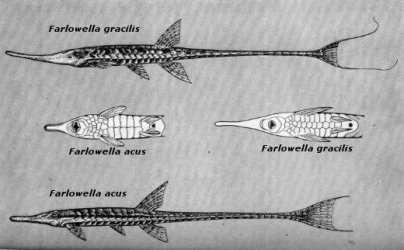The photos in the above post are not Farlowella, they are a Rineloricara sp. I'll come back to this "red lizard." The Farlowella are the smaller of the two genera, and include the lovely photos from TwoTankAmin above. The much larger "royal" Farlowella are in another genus.
The identification of this species is not a certainty. Of the 27 described species of Farlowella found throughout South America, only two are regularly exported. Most of the existing literature refers to these as F. acus and F. gracilis, but several authorities believe this is incorrect, and consider the fish offered as F. acus to in fact be the subject species. The sketch of F. acus [here F. vittata] and F. gracilis by Sterba shows the differences between the two commonly-available species. Both are identical in their requirements in the aquarium.
Farlowella differ from the other Loricaria fish in the positioning of the dorsal fin which is opposite the anal fin on Farlowella rather than anterior to it. Males have a broader rostrum (snout) and develop rows of bristle-like odontotes along it as they mature. Not difficult to spawn in very soft, acidic water and very dim lighting. The male guards the eggs; after hatching, the fry are difficult to raise since they require very soft vegetable matter. The writer (Byron) has had success using dried oak leaves which the fry will graze. I acquired three for my 90g tank, and after a year or slightly longer, it became evident there was a male and two females. The male will spawn with both females, and did a couple time simultaneously. He is very good at defending the young, but once they hatch they are on their own. I moved a few out of the 90g into the 10g with my pygmies, and they grew there.
My tap water is zero GH/KH, ith a very acidic pH, and I suspect this was a prime reason for this fish spawning.
The Red Lizard: It is a Loricarid, closely related to the species in Rineloricaria. The precise origin of this fish is a mystery. It may possibly be a natural species, but most sources believe it is a man-made hybrid from one or more other Rineloricaria species, but which exactly is also unknown. The German aquarium resource publisher Aqualog introduced this species with the number L010a, but it bears no resemblance to L010. The "L" system was initiated by the German aquarium magazine DATZ [Die Aquarien und Terrarienzeitschrift] to identify the newly-discovered loricarid species prior to the scientific description and naming; these numbers are applied to all known species including those already or once named, so they are unique to each species.
The "pure" strain of this species is now very difficult to obtain, probably only from Germany. It is more likely that fish available in stores will be hybrids. It was found that the original species, sometimes referred to as Leliella sp. "Red," would readily spawn with Rineloricaria lanceolata. Since the latter species is more prolific and easier to spawn, and this hybridization produces very red-coloured fish, commercial breeders preferred the hybrids. The pure species is preserved by some breeders in Germany.
The genus Rineloricaria was erected by Pieter Bleeker in 1862; the name is derived from the Greek rhinos [= nose] and lorica [= cuirass (which is a type of armour breastplate) of leather]. There are presently about 60 described species distributed from Panama down to northern Argentina, and on both sides of the Andes. This is the largest number of species in any Loricariinae genus. In 2008 alone, some 14 new species were described as Rineloricaria.
During the past ten years this genus has undergone classification changes which are still not fully resolved. Isbrucker et al.(2001) re-established the genus Hemiloricaria [Bleeker, 1862] as distinct, along with two new genera (Leliella and Fonchiiichthys), and on the basis of sexual dimorphism moved several species from Rineloricaria into these three. The latest classification, that of Rodriguez & Reis (2008), partly accepts Isbrucker et al. (2001) phenetic proposition of splitting Rineloricaria and Hemiloricaria; but they propose that Hemiloricaria should comprise a widely-distributed group of species (Amazon and non-Amazon species) whereas Rineloricaria would be restricted to species occurring in the Rio Parana and its tributaries, and the coastal drainages from Uruguay to northeastern Brazil. As of the time of writing, this has not been universally accepted.









